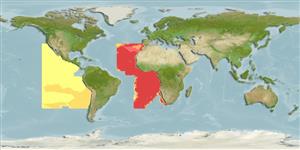>
Lampriformes (Velifers, tube-eyes and ribbonfishes) >
Radiicephalidae (Tapertails)
Etymology: Radiicephalus: Latin, radius + Greek, kephale = head (Ref. 45335).
Environment: milieu / climate zone / depth range / distribution range
ນິເວດວິທະຍາ
ສັດທະເລ; ລະດັບຄວາມເລິກ 570 - ? m (Ref. 58018). Deep-water; 38°N - 40°S, 130°W - 20°E
Eastern Atlantic: off Morocco and the Azores (Ref. 6739) southward to Cape Point, South Africa (Ref. 6551). Eastern Pacific: present in the California Current region (Ref. 36609).
ຂະໜາດ / ນ້ຳໜັກ / Age
Maturity: Lm ? range ? - ? cm
Max length : 76.0 cm TL ຕົວຜູ້/ບໍ່ມີເພດ; (Ref. 4506)
ຄີ (ໜາມ)ແຂງຢູ່ຫຼັງປາ (ທັງໝົດ) : 0; ຄີຫຼັງຂອງປາ (ຄີອ່ອນ) (ທັງໝົດ) : 152 - 160; ຄີ(ໜາມ) ແຂງຢູ່ຄີກົ້ນປາ
ກຸ່ມປາກະດູກແຂງ
ຄວາມຖີ່ຂອງກຸ່ມຖ່າຍທອດພັນ
ປາທີ່ມີການເຄື່ອນຍ້າຍຈາກທະເລໄປຫານ້ຳຈືດ ແລະນ້ຳຈືດຫາທະເລ
ປາທີ່ມີການເຄື່ອນຍ້າຍຈາກທະເລແລະໄປໄຂ່ຢູ່ນ້ຳຈືດ
ຄີກົ້ນຂອງປາ
ສັດທີ່ມີກະດູກສັນຫັຼງ
ການຖ່າຍທອດທາງກຳມະພັນຈາກພໍ່ແມ່ຫາລູກ: 0; ຄີກົ້ນຂອງປາ: 6 - 7; ສັດທີ່ມີກະດູກສັນຫຼັງ: 114 - 121. Body and tail silvery in color; dorsal base blackish (Ref. 6551). Branchiostegal rays: 4-6 (Ref. 36609). Pelvic fins absent in adults.
Mesopelagic species (Ref. 6808). Adults feed on lantern-fishes (Myctophidae) and possibly euphausiid crustaceans (Ref. 6739). Oviparous, with planktonic larvae (Ref. 36609). They have the ability to discharge dark brown fluid from the ink-sac when alarmed.
Life cycle and mating behavior
ການຈະເລີນເຕັມໄວ | ການສືບພັນ | ການວາງໄຂ່ | ໄຂ່ | ຄວາມດົກຂອງໄຂ່ປາ | ຕົວອ່ອນ
Aguiar, A. and J.-C. Quéro, 1990. Trachipteridae. p. 647-649. In J.C. Quero, J.C. Hureau, C. Karrer, A. Post and L. Saldanha (eds.) Check-list of the fishes of the eastern tropical Atlantic (CLOFETA). JNICT, Lisbon; SEI, Paris; and UNESCO, Paris. Vol. 2. (Ref. 4506)
IUCN Red List Status (Ref. 130435: Version 2024-1)
Threat to humans
Harmless
Human uses
ເຄື່ອງມື
Special reports
Download XML
ແຫຼ່ງອີນເຕີເນັດ
Estimates based on models
Preferred temperature (Ref.
123201): 4.5 - 7, mean 5.8 °C (based on 5 cells).
Phylogenetic diversity index (Ref.
82804): PD
50 = 1.5000 [Uniqueness, from 0.5 = low to 2.0 = high].
Bayesian length-weight: a=0.00389 (0.00180 - 0.00842), b=3.12 (2.94 - 3.30), in cm total length, based on all LWR estimates for this body shape (Ref.
93245).
ຊັ້ນເຂດຮ້ອນ (Ref.
69278): 3.9 ±0.63 se; based on food items.
Fishing Vulnerability (Ref.
59153): Moderate to high vulnerability (50 of 100).
